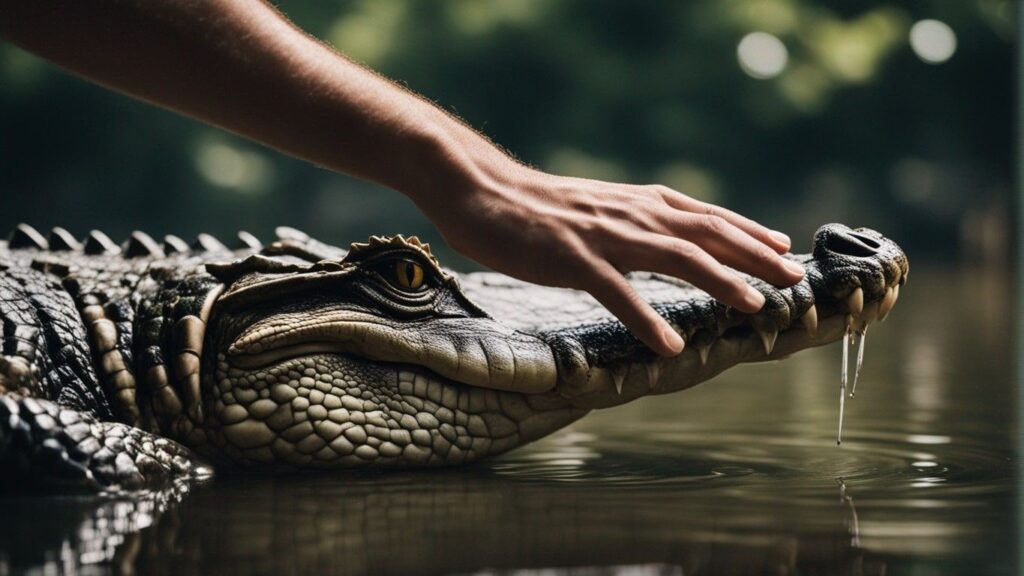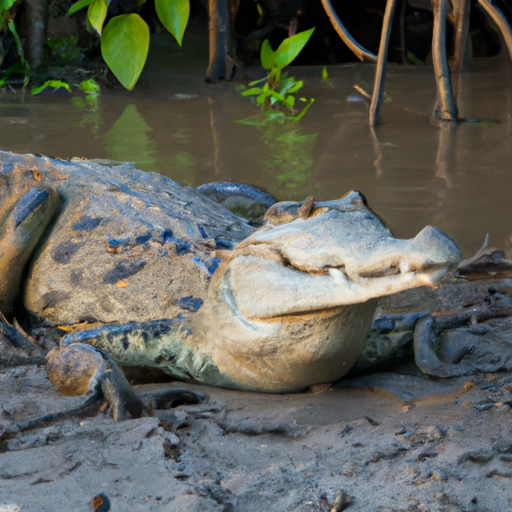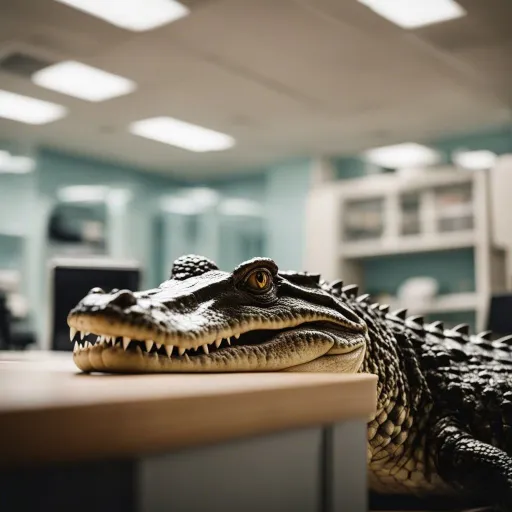So, you’re probably wondering if it’s possible to tame crocodiles, huh? Well, you’re in luck because this article is going to dive into the fascinating world of crocodile tameness.
We’ll explore whether these ancient reptiles can ever be domesticated, look at some instances where crocodiles have displayed surprisingly docile behavior, and examine the risks and challenges involved in attempting to tame these formidable creatures.
Get ready to unravel the mystery of whether it’s truly possible to tame these fearsome predators!
The Nature of Crocodiles
Crocodiles are fascinating creatures that have captivated humans for centuries. With their prehistoric appearance and formidable reputation, they bring a sense of awe and wonder.
Understanding the physical characteristics, habitat, behavior, and cognitive abilities of crocodiles is essential in order to comprehend their interactions with humans and the challenges of taming them.
Physical Characteristics
Crocodiles are well-adapted aquatic reptiles with strong bodies and long tails. Their muscular jaws are filled with sharp teeth, designed for catching and gripping prey.
They have a tough scaly skin, which acts as armor, protecting them from physical harm. On average, crocodiles can grow to be around 10-15 feet long, with some species reaching up to 20 feet.
Their streamlined bodies enable them to be agile swimmers and hunters, making them efficient predators in their natural habitats.
Habitat and Behavior
Crocodiles are primarily found in freshwater and brackish water habitats such as rivers, lakes, and marshes.
They are cold-blooded animals, relying on external sources of heat to regulate their body temperature. Crocodiles have unique features, such as their ability to remain motionless for extended periods, allowing them to camouflage and ambush their prey.
They are opportunistic hunters, feeding on fish, birds, mammals, and even other reptiles. Crocodiles are known for their territorial behavior, defending their feeding and breeding grounds with aggression. Mating occurs during specific seasons, and females lay eggs in nests they construct on land.
Cognitive Abilities
While crocodiles are often regarded as ancient and primitive creatures, they possess surprising cognitive abilities. Research has shown that crocodiles have excellent memory and problem-solving skills. They can navigate complex environments, remember the location of food sources, and even learn to associate certain sounds or stimuli with rewards. These cognitive abilities make crocodiles highly adaptable and capable of learning from and adjusting to their surroundings. Understanding the cognitive capabilities of crocodiles is crucial when considering their potential for taming and training.
Historical Relationship between Humans and Crocodiles
Crocodiles have a long-standing presence in human culture and history. They have been revered and feared in ancient civilizations, and their interactions with humans have evolved over time.
Crocodiles in Ancient Cultures
Ancient cultures such as the Egyptians, Greeks, and Aztecs saw crocodiles as powerful and divine creatures. In Ancient Egypt, crocodiles were worshipped and mummified, symbolizing fertility and protection. The Greeks depicted crocodiles in mythology and folklore, highlighting their strength and cunning nature. Among the Aztecs, crocodiles were associated with water deities and were believed to hold spiritual significance. These ancient interactions demonstrate the deep-rooted fascination and respect humans have had for crocodiles throughout history.
Crocodiles in Modern Times
In modern times, the relationship between humans and crocodiles has become more complex. With increasing encroachment of human settlements into crocodile habitats, conflicts and negative interactions have become more prevalent. Crocodile attacks on humans, livestock, and pets have led to fear and concern among local communities. As a result, efforts to manage and control crocodile populations have been implemented in many regions.
Conservation Efforts
Recognizing the ecological importance of crocodiles, there have been significant conservation efforts aimed at protecting these creatures. Conservation initiatives focus on preserving crocodile habitats, implementing sustainable management practices, and raising awareness about the importance of coexisting with crocodiles. By understanding the behaviors and needs of these reptiles, conservationists can better mitigate conflicts and promote the conservation of crocodile populations for future generations.
Methods of Crocodile Training
Taming crocodiles is a demanding task that requires careful consideration of their behavior, cognitive abilities, and the techniques used to train them. Various methods have been employed to tame and train crocodiles, allowing for important research, conservation, and community engagement opportunities.
Positive Reinforcement
Positive reinforcement is a widely used technique in crocodile training. By rewarding desired behaviors, such as responding to commands or demonstrating calmness, trainers can effectively shape the behavior of the crocodile. Rewards can range from food treats to tactile reinforcement, such as gentle petting or scratching. This positive association encourages crocodiles to repeat the desired behaviors, facilitating their training process.
Conditioning Techniques
Conditioning techniques, based on the principles of classical conditioning, are also employed in crocodile training. By associating certain stimuli or cues with specific behaviors, trainers can establish predictable patterns of responses from the crocodile. For example, a specific sound or gesture can signal the crocodile to perform a desired action. Through repeated pairing of the stimulus and behavior, the crocodile learns to associate the two and responds accordingly.
Physical Restraints
Physical restraints, such as ropes or harnesses, are used in some cases to control and handle crocodiles during training. These restraints help ensure the safety of both the trainers and the crocodiles while allowing for a controlled training environment. By gradually acclimating the crocodile to the physical restraints, trainers can reduce stress and aggression, enabling more effective training sessions.
Challenges of Taming Crocodiles
Taming crocodiles poses numerous challenges due to their instinctual aggression, limited domestication potential, and safety concerns.
Instinctual Aggression
Crocodiles are apex predators with deeply ingrained instincts for survival. Their aggressive nature and territorial behavior make them potentially dangerous when interacting with humans. Even with extensive training, there is always a level of unpredictability and the potential for instinctual aggression to override learned behaviors. Trainers must always prioritize safety and be prepared for any unforeseen circumstances.
Limited Domestication
Unlike domesticated animals such as dogs or horses, crocodiles have not undergone centuries of selective breeding for traits conducive to domestication. While captive crocodiles may exhibit certain behaviors learned in a controlled environment, their wild instincts remain intact. This limited domestication potential poses challenges in terms of fully taming crocodiles to the same extent as traditional domesticated animals.
Safety Concerns
Working with crocodiles involves inherent risks. The power and strength of these reptiles require experienced handlers who understand their behavior and have extensive knowledge of safety protocols. Accidents can happen even with the most stringent precautions, making it essential to prioritize the safety of both humans and crocodiles during training and interaction.
Famous Examples of Tamed Crocodiles
Despite the challenges of taming crocodiles, there have been notable examples of successful relationships between humans and these majestic creatures. These examples demonstrate the potential for establishing unique bonds and achieving positive outcomes through training and education.
Gomek: The Gentle Giant
Gomek, a Saltwater Crocodile, gained international fame for his gentle demeanor and interactions with humans. Captured in Papua New Guinea and later brought to the United States, Gomek became a star attraction at the St. Augustine Alligator Farm Zoological Park in Florida. Through positive reinforcement techniques and extensive training, Gomek learned to interact calmly with his handlers, allowing for important research and education opportunities. Gomek’s story highlighted the potential for mutual trust and understanding between humans and crocodiles.
Chito and Pocho: Unlikely Friends
Chito and Pocho, a fisherman and a captured American Crocodile, formed an improbable friendship in Costa Rica. Chito rescued Pocho from a traumatic injury and nursed him back to health. Through years of patience, trust, and training, Chito was able to establish a unique connection with Pocho, leading to a close bond between the two. Their story inspired many and showcased the potential for building deep relationships with crocodiles, even in unconventional circumstances.
Conservation Success Stories
Beyond individual examples, the taming and training of crocodiles have played vital roles in conservation efforts. By working closely with local communities and using trained crocodiles as ambassadors, conservation organizations have successfully raised awareness about the importance of protecting crocodile populations and their habitats. These efforts have led to increased public support and engagement in conservation initiatives, contributing to the preservation of these magnificent creatures.
Applications of Tamed Crocodiles
Tamed crocodiles offer various opportunities for research, education, and community engagement, contributing to broader conservation goals.
Research and Conservation
Tamed crocodiles serve as invaluable assets for scientific research and conservation studies. Their ability to be trained and handled safely allows researchers to collect important data, such as physiological measurements, behavioral observations, and reproductive studies. By gaining a deeper understanding of crocodile biology and behavior, conservationists can develop more effective management strategies and ensure the long-term survival of crocodile populations.
Tourism and Education
Tamed crocodiles can be used in responsible tourism and educational programs to raise awareness about these remarkable creatures. By providing opportunities for the public to interact with trained crocodiles, visitors can develop a greater appreciation for their importance in the ecosystem, ultimately fostering support for conservation efforts. Educational programs centered around tamed crocodiles can also help dispel misconceptions and promote a deeper understanding of crocodile behavior and their ecological roles.
Working with Local Communities
In regions where human-crocodile conflicts are prevalent, tamed crocodiles can play a vital role in engaging local communities and promoting peaceful coexistence. By working closely with these communities and facilitating educational initiatives, trainers and conservation organizations can foster dialogue, dispel fears, and develop strategies for minimizing conflicts. Training crocodiles to respond to specific commands or stimuli can also aid in relocation efforts, reducing negative encounters between humans and crocodiles.
Ethical Considerations
While taming crocodiles offers numerous benefits, it is essential to address ethical considerations surrounding animal welfare, conservation, and the balance between conservation and exploitation.
Animal Welfare Concerns
The welfare of crocodiles should always be a primary concern when taming and training them. Care must be taken to ensure the physical and mental well-being of these animals throughout the training process. Captive environments must meet high standards of space, temperature, water quality, and enrichment to provide for the crocodiles’ unique needs. Trainers and facilities should prioritize the welfare of the animals and promote humane treatment at all times.
Balancing Conservation and Exploitation
Tamed crocodiles should be used as tools for conservation and education, rather than for exploitation or entertainment purposes. Responsible use of tamed crocodiles should be guided by a commitment to conservation goals, scientific research, and community engagement. It is essential to strike a balance between generating public interest and support and ensuring the welfare and well-being of the animals involved.
Effectiveness and Sustainability
When considering the taming and training of crocodiles, it is crucial to assess the long-term effectiveness and sustainability of such endeavors. Training programs should continually evaluate their methods and adapt them based on scientific advancements and ethical considerations. Transparency and accountability are key in ensuring that endeavors involving tamed crocodiles are conducted with the utmost professionalism and maintain a focus on the overall well-being and conservation of these creatures.
Future Prospects of Crocodile Taming
While taming crocodiles remains a challenging endeavor, ongoing research, innovation, and a holistic approach can lead to continued progress and advancements in this field.
Continued Research and Innovation
Advancements in our understanding of crocodile behavior, cognitive abilities, and welfare considerations will inform future training practices. Continued research into effective training techniques, stress reduction methods, and the biology of crocodiles will contribute to the development of more ethical and sustainable ways to tame and train these magnificent creatures.
Balancing Interests and Priorities
As the demand for responsible tourism and community engagement increases, striking a balance between conservation goals, local community needs, and responsible exploitation becomes crucial. Collaboration between conservation organizations, governments, and local communities is essential in developing comprehensive strategies that prioritize the well-being of crocodiles, the livelihoods of communities, and the long-term conservation efforts.
The Role of Public Perception
Public perception plays a significant role in shaping attitudes toward crocodile taming and training. Educating the public about the complexity and challenges of working with crocodiles can help dispel misconceptions and foster appreciation for the importance of responsible interactions. Raising awareness about successful conservation stories and showcasing the value of tamed crocodiles in research and education can generate support and public interest in preserving these unique creatures.
Conclusion
Taming crocodiles is a complex and challenging endeavor that requires a deep understanding of their physical characteristics, behaviors, and cognitive abilities.
While significant progress has been made in establishing unique bonds and achieving positive outcomes through training, it is essential to balance ethical considerations and conservation goals.
Responsible taming and training of crocodiles have the potential to contribute to crucial research, education, and community engagement initiatives, fostering sustainable coexistence between humans and these incredible creatures.
With continued research, innovation, and a commitment to animal welfare, taming crocodiles can be a fascinating yet challenging journey towards understanding and protecting one of nature’s most awe-inspiring creatures.




